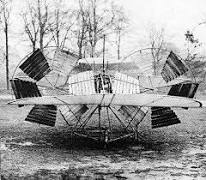history of aeronautics
Aeronautics (from Greek ὰήρ āēr which means "air" and ναυτικήnautikē which means "navigation, seamanship", i.e. "navigation of the air") is the science involved with the study, design, and manufacture of flight-capable machines, or the techniques of operating aircraft. While the term—literally meaning "sailing the air"—originally referred solely to the science of operating the aircraft, it has since been expanded to include technology, business and other aspects related to aircraft.One of the significant parts in aeronautics is a branch of physical science called aerodynamics, which deals with the motion of air and the way that it interacts with objects in motion, such as an aircraft.Aircraft is a term sometimes used interchangeably with aeronautics, although "aeronautics" includes lighter-than-air craft such as airships, while "aviation" does not.

Early aeronautics
 The first mention of aeronautics in history was in the writings of ancient Egyptians who described the flight of birds. It also finds mention in ancient China where people were flying kites thousands of years ago. The medieval Islamic scientists were not far behind, as they understood the actual mechanism of bird flight. Before scientific investigation of aeronautics started, people started thinking of ways to fly. In a Greek legend, lcarus and his father Daedalus built wings of feathers and wax and flew out of a prison. Icarus flew too close to the sun, the wax melted, and he fell in the sea and drowned. When people started to scientifically study how to fly, people began to understand the basics of air and aerodynamics.lbn Firnas may have tried to fly in 8th century in Cordoba, Al-Andalus.
The first mention of aeronautics in history was in the writings of ancient Egyptians who described the flight of birds. It also finds mention in ancient China where people were flying kites thousands of years ago. The medieval Islamic scientists were not far behind, as they understood the actual mechanism of bird flight. Before scientific investigation of aeronautics started, people started thinking of ways to fly. In a Greek legend, lcarus and his father Daedalus built wings of feathers and wax and flew out of a prison. Icarus flew too close to the sun, the wax melted, and he fell in the sea and drowned. When people started to scientifically study how to fly, people began to understand the basics of air and aerodynamics.lbn Firnas may have tried to fly in 8th century in Cordoba, Al-Andalus.Although the ornithopter continues to be of interest to hobbyists, it was replaced by the glider in the 19th century. Sir George cayley was one of the most important people in the history of aeronautics. Many consider him the first true scientific aerial investigator and the first person to understand the underlying principles and forces of flight. A pioneer of aeronautical engineering, he is credited as the first person to separate the forces of lift and drag which are in effect on any flight vehicle, Francesco Lanade Terzi, a 17th century Jesuit professor of physics and mathematics from Brescia, Lombardy, has been referred to as the Father of Aeronautics. In his work Prodromo dell'Arte Maestra (1670) he proposes a lighter-than-air vessel based on logical deductions from previous work ranging from Archimedes and Euclid to his contemporaries Robert Boyle and Otto von Guericke.
No comments:
Post a Comment